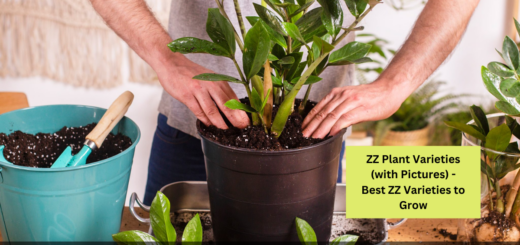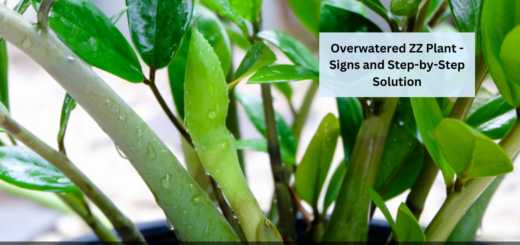What is Zamioculcas Zamiifolia or a ZZ plant? – How to Grow and Care for ZZ Plant?
I was in search of a low-maintenance indoor plant, and my friend suggested the ZZ plant. After giving it a try, I was pleasantly surprised by how well it grew and happy that I decided to grow it.
I understand that many of you may be curious about how I successfully grew and maintained the greenery of the ZZ plant for a longer time. To assist you, I’ve outlined all the steps I took to ensure the ZZ plant thrived. So, let’s not waste any time and start growing the ZZ plant together!
Quick takeaways:
- The common name of the ZZ plant is ‘Zanzibar Gems’.
- Some features of ZZ plants are growing process is slow, Height is upto -3 ft, Leaflets are 4-5 inches, etc.
- The different ways to take care of ZZ plants are by potting, repotting, and Pruning.
Zamioculcas Zamiifolia or a ZZ plant:
ZZ plant, scientifically known as Zamioculcas zamifolia are rhizome plant, and one of those that need the least ‘look after by the planters, looks healthy all the time with its shiny leathery green leaves, which makes them a great indoor plant. The common name is ‘Zanzibar Gems’ and the family Philodendron. Native to Africa so are used to tolerating inadequate conditions. This article will help you to gain more information about Zamioculcas Zamiifolia or a ZZ plant and also How to Grow and Care for ZZ Plant!
Features of ZZ plant:
- Height -3 ft
- Low light and yet bright one
- Water needs are frequent though they can still thrive better if the water level is low.
- Report not needed if want to do spring or summer is the perfect time
- The growing process is slow.
- They are perennial
- Though they don’t usually flower if they do, the color is creamish
- Leaflets are 4-5 inches and grow alternatively throughout the stem.
- Can tolerate low to high humidity
Common points
The following table gives you all the basic points for growing ZZ plant:
| Plant Type: | Tropical evergreen perennial |
| Native to: | Eastern Africa |
| Hardiness (USDA Zone): | 9-11 (outdoors) |
| Bloom Time: | Spring (rare for houseplants) |
| Exposure: | Bright-low indirect light |
| Time to Maturity: | 3-5 years |
| Planting Depth: | Depth of the root ball |
| Height: | 3-5 feet |
| Spread: | 2 feet |
| Common Pests and Disease: | Aphids; Root rot |
| Flower/Foliage Color | White (rare indoors)/dark green |
| Maintenance: | Low |
| Tolerance | Drought, low light |
| Soil Type: | Porous potting mix |
| Soil pH: | 6.0-7.0 |
| Soil Drainage: | Well-draining |
| Water Needs: | Low |
| Family: | Araceae |
| Genus: | Zamioculcas |
| Species | Zamiifolia |
How to grow ZZ plants?
- Grow the plant just like Kabocha squash in a container and place it on a spot that has a bright light, though the ZZ plant can withstand high sun rays to partial shade. But if they do they want the “bright side”
- The light should not be the direct one that can bring dullness to the leaves and spotting.
- The soil while planting it, should be well fertilized and well-drained, moist too. It is also important that the ZZ plant is grown well if the temperature at night does drop too much. It grows well in warm temperatures between 64-74 degrees Fahrenheit.
How to care for ZZ plants?
Watering when needed is essential. Avoid overwatering to keep the plant leaves and stem away from a rotting problem
Potting: The size at the beginning of planting does not matter that much. Rather there should be holes on the surface of the pots for proper water drainage
Repotting: Repotting also does not cause an effect but if you want to report it, avoid doing this too many times a year and also go for it as soon as the spring comes.
Spray the leaves with water to keep them moist and away from the dust. The leaves should be cleaned with a soft cloth as the dirt buildup can be easily seen.
Pruning: In most ZZ plants, pruning has not benefited the growth as it would do nothing to its growth. You can do the shaping and remove the dead dull leaves though!
Are ZZ plants harmful? Do they cause cancer?
Yes, they can be harmful as reportedly they are seen to cause skin problems and can be toxic for children and pets if swallowed.
And for cancer, no they don’t cause cancer but being toxic and poisonous you need to be cautious while working on it, near it. You should wear gloves while cutting the stems or leaves as their sap might contain calcium oxalate causing skin issues.
Benefits of ZZ plants at home
- They have high adaptability and remove pollutants wherever they are. They are good natural air purifiers like other air purifier plants are Lavender, Monstera Deliciosa, Barberton Daisy, Chrysanthemum, etc.
- Needs less care and are self-sufficient plants come from the extreme wild conditions of Africa
- They are easy to propagate with cuttings, leaves, etc.
- Grow equally well outdoors and indoors.
- They look ultra graceful and beautiful in marble or white pots on the table.
Propagation of ZZ plant
In the following ways, you can do the propagation of ZZ plants:
If you are propagating by the division method, make sure the rhizome has a stalk part before replanting it. In the case of cutting leaves and leaf stalks. Keep a tiny part of the stem intact with the leaf while you are cutting it. Place it directly into the damp soil, a sunny spot.
You can try this method to elevate the propagation process by cutting a whole leaf stalk, putting it into a moist meshy cloth or water, waiting for roots to appear, and planting it as you want.

ZZ plants lifespan
ZZ plants have a lifespan of approximately 5-6 months. The plants can face harsh climatic conditions and withstand water for a long time.
Types of ZZ Plant
The following are some ZZ plant varieties:
Zamioculcas zamiifolia ‘Raven’:
This ZZ plant does have dark purple Maroon foliage which makes it different from other plants.
Zamioculcas zamiifolia ‘Lucky Variegated’:
This ZZ lucky variegated plant does contain green foliage having white and yellow variegated which does fade if they are not given proper light.
Zamioculcas zamiifolia ‘Zamicro’:
This ZZ plant type does have a dwarf version of the plant
Growing Tips:
For growing ZZ plants you need to follow some drawing tips that will help you to grow them in a healthy and beautiful way:
- You need to provide the plant with bright indirect light to make sure the plant doesn’t get in touch with directions.
- To fulfill their water needs you need to water them every couple of weeks but before that make sure to check the soil gets dry then only water the plant.
- You need to mist the foliage whenever the environment is dry.
Problems and pests of ZZ plants
- These plants are fighters but in some cases can get infected by aphids, mites, mealybugs, and spider mites. These can be removed by spraying water or using insecticides.
- The leaves might turn yellow if you are overwatering the plants. The yellow leaves will die and feel off or you can remove them by yourself to save others.
- Due to root blockage, many times this plant gets leaned down on one side or seems droopy, as the proper transport of water is not there.
Wrapping up the context:
Hope you have understood all the essential details regarding the ZZ plant. To grow the ZZ plant in your house to need to follow all the important points so that you get the benefits of the plant and add more greenery to your house, We are here happy to help you always!
Check this link to know further,
FAQ:
Where should I place my ZZ plant at home?
It is efficient to place the ZZ plant in indirect low sunlight that is bright enough. It is advisable to place it near the window facing north, east, or west direction.
Is the ZZ plant good for the bedroom?
These plants can be placed anywhere in the house whether in the bedroom, hall, study room, etc. they are perfect to give a graceful, striking look.
Is the ZZ plant lucky?
The ZZ plants are evergreen and give a green lush of leaves. They are considered lucky as they enhance wealth and bring prosperity to life.
How do I get my ZZ plant to grow more leaves?
To enhance the growth of more leaves, the usual pruning case will not work here. Instead go for cutting the stem right at the bottom near the rhizome, as the plant is a rhizome type and the rhizome is the “decision-maker” here.


